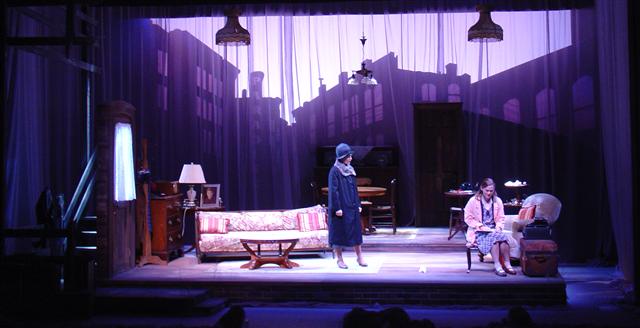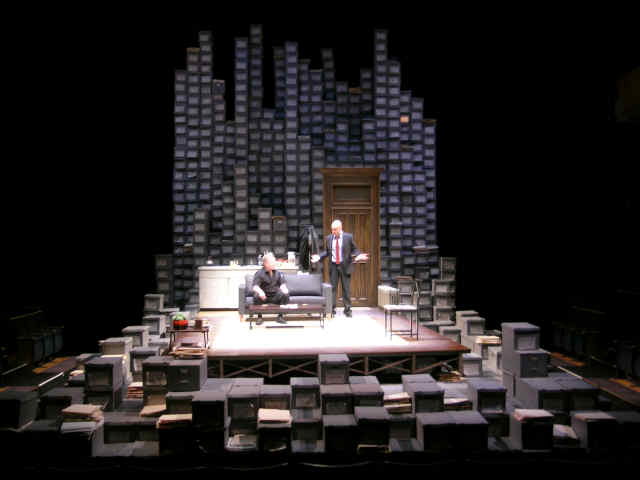One of the first cultural points of reference we identified for Kentucky Route Zero was 20th century American tragic theatre -- plays by people like Tennessee Williams, Arthur Miller, and Eugene O'Neill. Over the last few months we've been taking a much closer look at set design (especially American set design) as a point of reference for the environments in the game. This visual influence was always present to a certain degree, but lately we've made it much more explicit and we've been researching it much more thoroughly. In the process we've come across a few designers we really like, and some interesting parallels between set design and game development, so we'd like to share those with you now.

Beowulf Boritt
designed a production of Tennessee Williams' "The Glass Menagerie" in 2009. More photos and details
on his website
. The background of the set is obviously not meant to be "realistic" exactly; it's a graphic, almost cartoony illustration of the city outside the window. But instead of putting an apartment wall, maybe a window with the city visible outside, Boritt magnifies the ambient context of the scene and throws this huge illustration as a backdrop. It brings the context of the story to the surface, which is important since -- like most of Williams' writing -- this play is about small whitecaps of human struggle and tragedy cresting on a larger sea of social turmoil. It also makes the setting kind of muddy and psychological, which is appropriate since the text of "The Glass Menagerie" is, on its face, a man narrating his memories.

We were also really taken by this bizarre and beautiful set Boritt made for a production of the play "
A Number
" in 2008. In this play, several of the characters are clones, and in Boritt's design those piles of boxes contained clothes that one actor would retrieve & change into in order to switch characters.
Both of these Beowulf Boritt designs do something that videogames are also doing quite a lot of: play fast and loose with representation in order to serve some important interaction. The backdrop in "The Glass Menagerie" makes the city literally surround the characters and their interactions. The skyline of boxes in "A Number" is a representation of a certain kind of space -- an oppressive, modern, urban environment -- but it's also literally a wardrobe of identities for one of the actors (and his characters' gene sequence). Compare these to something like the "healing herb" trope in videogames -- a magic plant that grows wild and at once textures the local landscape and by its presence or absence regulates the difficulty of the game.

This is a design by Bob Crowley from the play "The Habit of Art." In this design, only the walls/floors/ceilings that are absolutely necessary are visible -- that is, there are no structural elements that are purely decorative or meant to trick the audience into forgetting the missing fourth wall. But still the set feels cluttered, kind of messy, like someone's work/live space in the middle of an important project. It's still communicates a very specific time and place, without overdetermining it by trying to simulate a fully-contained environment. Doing so, it leaves room for the actors to impart their own environmental cues -- acting tired to suggest that it's morning, or drinking whiskey to suggest it's evening (or morning). As we develop Kentucky Route Zero, the dialog and environmental design are in constant communication, but both of us are finding ways to leave openings like Crowley does, in order to let the other part speak.
One other small update!
A few weeks ago, Kickstarter and videogame magazine
Kill Screen
hosted a party at Kickstarter's offices, playing games funded on the site. They had several great games running, including
Octodad 2
(being developed by some of our friends here in Chicago!) and a small prototype of Kentucky Route Zero. We were flattered they asked us to be involved, and of course we'd like to share that prototype with you as well.
We're both web developers, so sometimes it's easiest for us to sketch things out in the form of a web page to figure out its behavior, and then port it over to Unity to include in the game. This is one of those web page prototypes. We were experimenting with some new behaviors for the dialog engine and also with some parts of the art treatment, and because of the timing of their event it made sense to send this prototype/sketch to Kickstarter & Kill Screen.
We have just a few caveats about this prototype:
- It works best in the Safari browser. Failing that, it works pretty OK in Chrome. It's not great in Firefox. Internet Explorer probably just spends your tax return, I don't know.
- Because this is a web page and not actually in the game engine, there are some important graphical things we couldn't do here, like primarily dynamic lighting and fun stuff with camera perspective.
- The game's font doesn't embed properly in web browsers on Windows, so we're just using a stock browser font here. The real one is much nicer :)
more soon!
jake+tamas